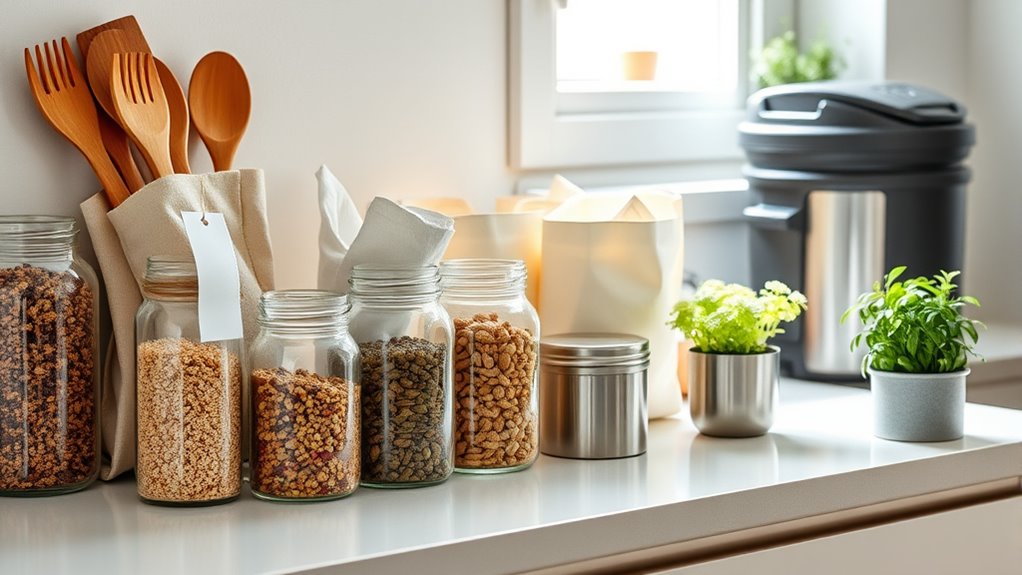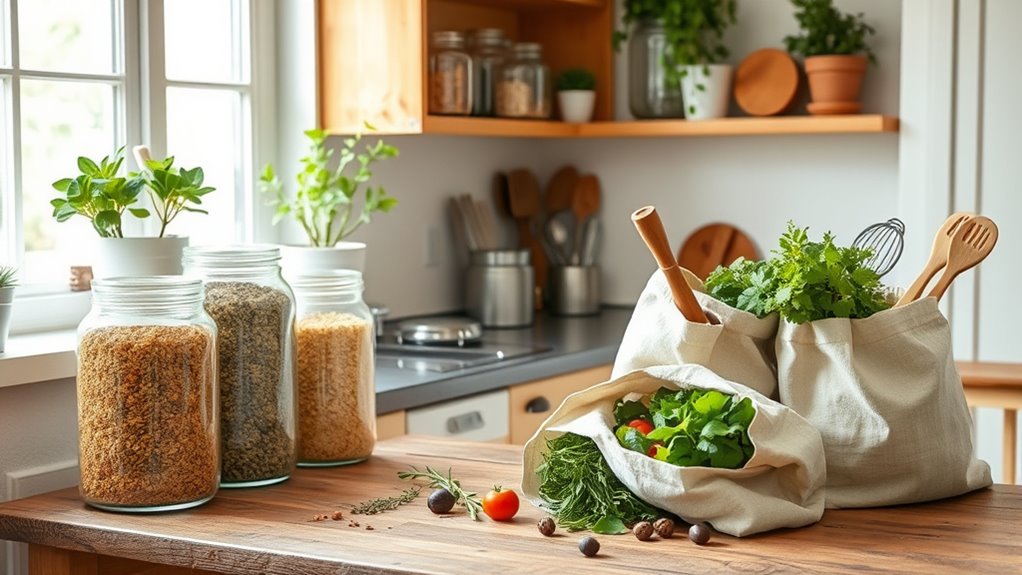To reduce food packaging and waste in your kitchen, start by using reusable containers instead of single-use plastics and bring your own bags for shopping. Compost food scraps like vegetable peels and coffee grounds to minimize waste and create nutrient-rich soil. Shop mindfully by choosing loose produce and minimal packaging items. Organizing your space and planning meals reduce leftovers and spoilage. Keep exploring these simple tips to make your kitchen more sustainable and waste-free.
Key Takeaways
- Use reusable containers made of glass or stainless steel instead of single-use plastics for packaging and storage.
- Compost food scraps like vegetable peels, coffee grounds, and eggshells to reduce waste and enrich soil.
- Shop with minimal packaging by choosing loose produce and bringing your own reusable bags.
- Plan meals and buy only necessary items to prevent excess packaging and food spoilage.
- Organize your kitchen to facilitate waste-reduction practices, such as designated compost and storage areas.

Creating a zero-waste kitchen is an achievable way to reduce your environmental impact while saving money. One of the most effective strategies is to replace single-use packaging with reusable containers. Instead of relying on plastic wrap or disposable bags, invest in glass or stainless steel containers that can store everything from leftovers to bulk pantry items. Reusable containers not only cut down on waste but also keep your food fresh longer. When shopping, bring your own containers to bulk stores, allowing you to buy exactly what you need without packaging waste. This simple change can dramatically decrease the amount of plastic and paper waste generated in your kitchen.
Replace single-use packaging with reusable containers to cut waste and keep food fresh longer.
In addition to using reusable containers, developing a solid composting routine is key to minimizing food waste. Composting methods have evolved to accommodate different living situations, so you can choose one that fits your space and lifestyle. For example, if you have a backyard, a traditional compost bin or tumbler works well to break down vegetable scraps, coffee grounds, eggshells, and other compostable materials. If you live in an apartment or lack outdoor space, consider a countertop compost bin with a charcoal filter to contain odors. Some communities even offer curbside composting programs, making it easier to divert food scraps from landfills. Composting not only reduces waste but also creates nutrient-rich soil that can be used in your garden or houseplants, closing the loop on food waste.
To maximize your zero-waste efforts, plan your meals and shopping trips carefully. By buying only what you need, you limit excess packaging and reduce the chances of food spoilage. When purchasing items, opt for loose produce or products with minimal packaging, and always carry your reusable bags. Keep your kitchen organized with designated areas for reusable containers and compost supplies, making it easy to stick to your waste-reduction habits daily. Educating yourself on composting methods and staying consistent with your use of reusable containers can make a significant difference over time. This approach not only helps the environment but also encourages mindful consumption, leading to less clutter and more savings in your household.
Incorporating these habits into your routine transforms your kitchen into a more sustainable space. By choosing reusable containers and adopting composting methods, you actively reduce waste and contribute to a healthier planet. Small changes, when practiced consistently, can have a lasting impact, proving that living zero-waste isn’t just an ideal but an achievable goal.
Frequently Asked Questions
How Can I Start a Zero-Waste Kitchen on a Tight Budget?
To start a zero-waste kitchen on a tight budget, focus on budget-friendly swaps like using cloth produce bags and glass jars instead of plastic. Incorporate DIY zero waste hacks such as making your own reusable wraps and cleaning products. Shop at local bulk stores for affordable, package-free items, and prioritize reducing food waste by meal planning. These simple steps help you create an eco-friendly kitchen without breaking the bank.
What Are the Best Reusable Containers for Food Storage?
You should choose versatile, durable reusable containers like glass containers or stainless steel options. Glass containers are great for storing leftovers; they’re microwave-safe and don’t stain. Stainless steel options are lightweight, unbreakable, and perfect for packing lunches. Both types are eco-friendly, safe, and long-lasting, making them ideal for reducing waste. Pick a variety of sizes to suit different foods, and you’ll be well on your way to a zero-waste kitchen.
How Do I Handle Food Waste Composting at Home?
To handle food waste composting at home, start by choosing a composting method that fits your space, like a tumbling bin or a simple pile. You’ll benefit from composting by reducing landfill waste and creating nutrient-rich soil for your plants. Be sure to balance greens and browns, turn your compost regularly, and keep it moist. This way, you’ll enjoy cleaner, healthier waste management and support sustainable living.
Which Stores Offer the Most Zero-Waste Packaging Options?
You’ll find the most zero-waste packaging options at stores with bulk shopping and refill stations. Look for co-ops, natural food stores, or specialty bulk shops, where you can bring your own containers. These stores often offer grains, nuts, and cleaning supplies without packaging, making it easy to reduce waste. Supporting these places helps you cut down on single-use plastics and embrace a more sustainable, zero-waste lifestyle.
How Can I Reduce Plastic Packaging When Shopping for Produce?
Think of your shopping cart as a garden, and every plastic bag is a weed choking growth. To cut plastic packaging, use reusable produce bags instead of single-use ones, making your choices more sustainable. Practice bulk buying tips by selecting loose fruits and vegetables, which minimizes waste and packaging. This way, you’re nurturing a greener planet, one mindful purchase at a time, turning your shopping habits into a powerful act of environmental stewardship.
Conclusion
By embracing these zero-waste kitchen tips, you’ll not only cut down on packaging but also discover how small changes can make a big difference. Imagine turning your everyday routines into eco-friendly habits—maybe even inspiring friends or neighbors without even trying. It’s funny how a simple shift in your kitchen can ripple outward, creating a more sustainable world. So, next time you cook, remember: your tiny actions have the power to transform the planet—one meal at a time.









